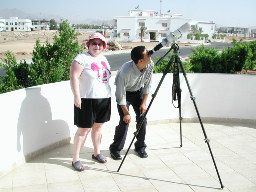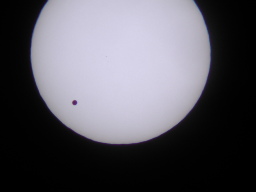The Egyptian Adventure
If it was good enough for Captain Cook to go halfway round the globe to see the rare transit of Venus, it was certainly good enough for us. The flight to Egypt in itself was exciting when we flew across Cairo and could see the Pyramids from the plane. On the descent into Sharm airport the mountainous desert scenery resembled the surface of Mars as the sand had a reddish colour. If you looked hard enough the occasional glint of metal could have been chunks of Beagle II!

Russell setting out to set up
The large group of astronomers settled quickly into their allocated hotels and realised from the absolutely clear, cloudless sky that the trip to see this rare event would not prove fruitless.
After a relaxing first full day the evening was given over to a talk by Dr John Mason on the forthcoming transit. The information he gave about this historical event was very similar to the talk we had at AFA the month before but contained lots of practical advice on the pitfalls of the observation. It was a bit different sitting in the open air on a hotel roof listening to the talk, while Scorpius was rising ever higher on your left hand side and Jupiter and Leo were visible just above the projection screen. Of course safe observing of the transit was hammered home. Not just the advice never to look directly at the sun but also to slap on as much sunscreen as possible as 6 hours in the baking heat would be a factor too!

Diane and other guest
An early start the next day as the transit began around 8.19am local time. Lots of observers set up their equipment on various vantage points around the hotel. As we waited for the transit to begin some of the hotel staff asked what was happening and we explained using lots of hand signals.
Then a small bite disappeared out of the sun at 1st contact and we watched as Venus inched slowly toward 2nd contact. As 2nd contact approached, the black drop effect became more apparent although you felt at the time that you could have been imagining it. Thankfully it was caught on camera along with a very prominent filament effect.

Douglas:
'be prepared for anything'
Then came the endurance test as Venus tracked slowly across the sun for the next five hours (Venus only moves its own diameter every 20 minutes). Some hardy souls stayed by their equipment and recorded the whole event. Others sought refuge from the 42 deg heat and went for a swim or retreated into the shade of their air conditioned rooms.
We were just gearing up for 3rd contact when disaster struck. A few hours in the heat had not done the equipment much good (and some of the observers by the look on their tomato red faces). The heat appears to have loosened the grip of the tripod head and a few minutes before 3rd contact Martin's Takahashi FS 60mm with digital camera still attached parted company with the tripod and nose-dived onto the tiled floor and bounced across it as we watched in horror. Six inches the other way it would have fallen twenty feet onto solid concrete. Thankfully apart from a dent on the dew shield it was still in perfect working order except the solar filter (Baader film and a cornflake packet) was ruined.

What it was all about
Another astronomical event that was laid on for us was a trip into the desert at night to do some observing. In preparation for our desert trip, the talks on the Tuesday night were about the comets that were currently visible and a very interesting talk called Underneath the Archer about some of the unfamiliar constellations we would see from our location closer to the equator. When we got to the desert location the next night we were given Bedouin blankets to lie on the ground so we could look up at the stars in comfort. Dr John Mason started off the evening with a living planetarium presentation using a laser pointer and the actual dome of the sky above us. We lay on the blanket and sipped Bedouin tea and watched Scorpius rising with the brilliant red star Antares blazing away, the Milky Way clearly visible and the occasional Ophiucid meteor streaking across the sky. The sky was quite unfamiliar but nonetheless glorious and the area around Lupus and Centaurus was stunning. Sagittarius rose later on in the evening but in the meantime, because the sky was unfamiliar, each of us had imagined our own teapot in different areas of the sky! The real teapot when it rose was unmistakeable and it has star clouds of the Milky Way boiling out of its spout! One of the highlights of the holiday.
A few nights later we went on an evening cruise and watched a spectacular sunset, and later, the stars rising above the sea.
All in all an interesting trip, to the most foreign place we have ever been, to see one of the rarest astronomical events. As we missed 3rd and 4th contact, looks like we'll need to go to Tahiti in 2012! See you there?